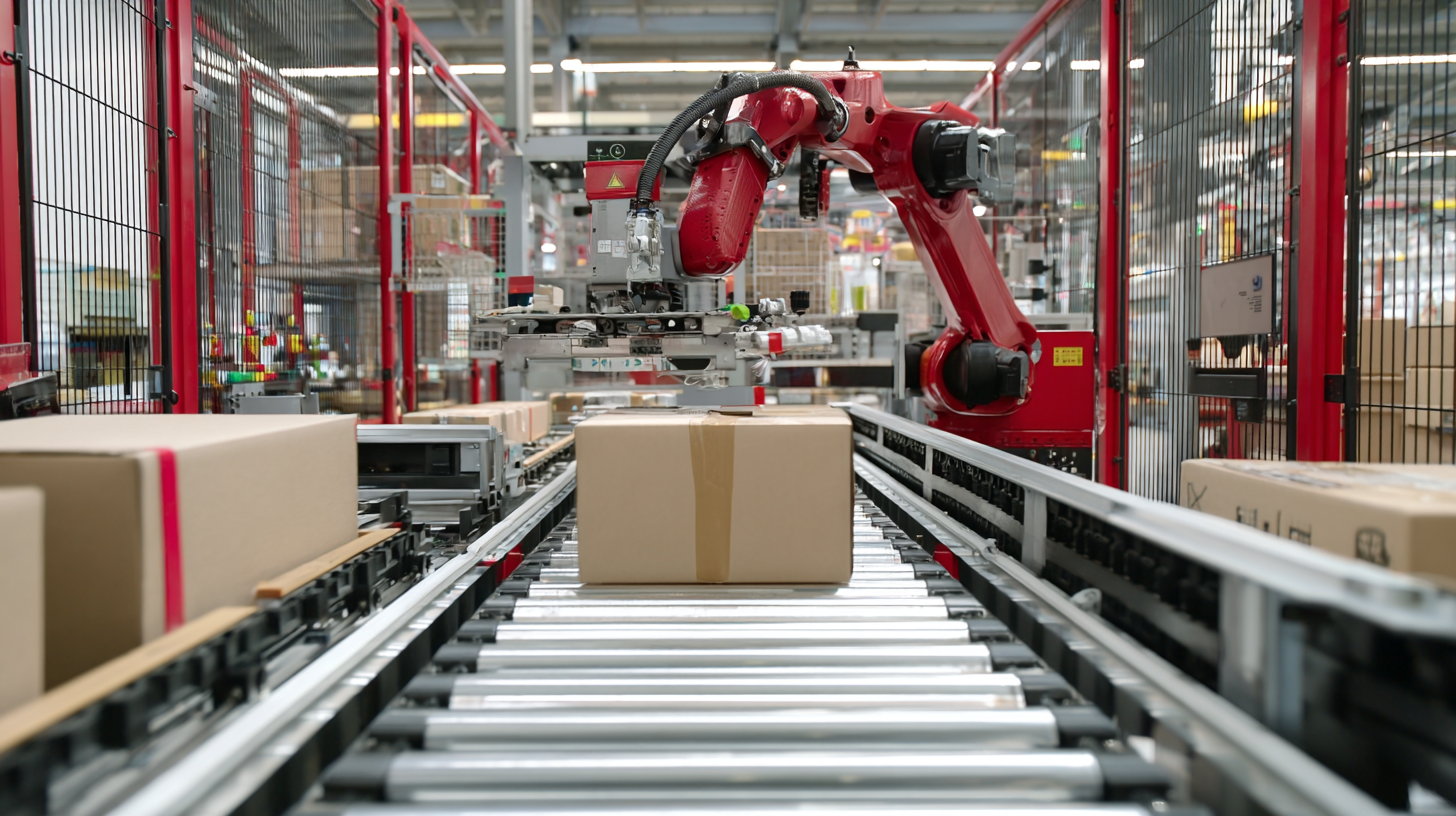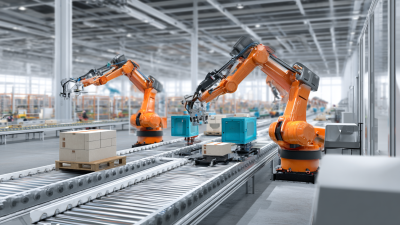Transforming Logistics: Cobot Palletizers at the 138th Canton Fair 2025 – Industry Insights and Innovations
In recent years, the logistics industry has witnessed unprecedented advancements, particularly with the integration of automation technologies. One such innovation that stands out is the cobot palletizer, a versatile robotic solution designed to enhance efficiency in packing and palletizing operations.

According to a report by Research and Markets, the global cobot market is expected to grow at a CAGR of 34% from 2021 to 2028, driven by the demand for high-performance, flexible automation solutions across various sectors. The upcoming 138th Canton Fair in 2025 serves as a pivotal platform for showcasing these innovations, highlighting how cobot palletizers are revolutionizing supply chains by minimizing labor costs and maximizing productivity.
As logistics players increasingly adopt smart automation, the role of cobot palletizers is destined to become even more crucial, transforming traditional approaches to goods handling and distribution.
Emergence of Cobot Palletizers: Redefining Efficiency in Logistics
The emergence of cobot palletizers is set to redefine efficiency in logistics, particularly showcased at the 138th Canton Fair 2025. These automated solutions are revolutionizing how businesses manage their supply chains by enhancing productivity and reducing manual labor. With advancements in collaborative robotics, companies are now able to streamline their palletizing processes, integrating them seamlessly into existing workflows. This innovation not only saves time but also minimizes operational costs, providing a significant boost to overall efficiency.
Tips: When considering the implementation of cobot palletizers, businesses should assess their current operations to identify potential areas for improvement. Investing in training for staff to work alongside these technologies is also crucial, ensuring a smooth transition that maximizes productivity. Furthermore, keeping abreast of developments in robotics will help companies stay competitive in an ever-evolving market.
The trend towards automation in logistics mirrors advances in other sectors, where efficiency and innovation are keys to success. Similar to breakthroughs in energy efficiency or improvements in AI capabilities, the move towards cobot palletizers illustrates the growing demand for smart solutions in the logistics industry. Companies that embrace these changes are likely to lead the way in establishing new standards of operational excellence.
Market Growth Projections: The Rise of Collaborative Robotics in Supply Chains
The exponential growth of the e-commerce industry over the past decade has significantly fueled the market for collaborative robotics within supply chains. As online shopping continues to rise, the demand for efficient logistics solutions becomes paramount. According to recent projections, the global supply chain management market is expected to grow from $262.5 billion in 2024 to $637.7 billion by 2032, demonstrating a robust compound annual growth rate. This soaring demand presents a ripe opportunity for the adoption of cobot palletizers, which automate and streamline the palletizing process.
**Tip:** Investing in collaborative robotics can optimize labor efficiency and reduce the time needed for order fulfillment. Implementing such technologies can provide companies with a competitive edge in this fast-paced environment.
Moreover, the penetration of Internet technology and the growth of user bases have accelerated the transformation within logistics. With increasing data from structured and unstructured sources, businesses can leverage big data analytics to enhance their supply chain operations. As noted in industry reports, the automated palletizer market alone is projected to rise from $7.58 billion to $11.53 billion by 2031, showcasing the growing reliance on automation in logistics.
**Tip:** Prioritizing smart logistics solutions and data-driven strategies can help firms meet the evolving demands of e-commerce, ultimately fostering long-term growth and efficiency.
Transforming Logistics: Cobot Palletizers Market Growth Projections
This chart illustrates the projected market growth of cobot palletizers from 2019 to 2025, showcasing the increasing adoption of collaborative robotics in supply chains and logistics. The steady increase signifies strong industry trends towards automation and efficiency in logistics operations.
Case Studies: Successful Implementations of Cobot Palletizers in Industry
At the 138th Canton Fair in 2025, the focus on Cobot palletizers reflects the growing shift towards intelligent automation in logistics. Case studies from various industries reveal significant benefits from integrating collaborative robots into palletizing processes. For instance, a study conducted in the food and beverage sector demonstrated a 30% increase in efficiency and a 25% reduction in injury rates since adopting cobots for repetitive tasks. This not only elevates productivity but also enhances workplace safety, showcasing a win-win scenario for employees and employers alike.
Additionally, recent research indicates that 65% of manufacturers are planning to incorporate cobots by 2025, as they adapt to the challenges posed by labor shortages and increased demand for customized products. The role of Cobotics within Industry 5.0 emphasizes the importance of harmonious human-robot collaboration. Case studies highlight successful transitions where cobots handle monotonous tasks, allowing human workers to engage in more complex responsibilities, thus fostering an innovative and inclusive work environment. This synergistic approach not only drives operational efficiency but also improves job satisfaction among employees.

Technological Innovations: Key Features of Next-Gen Cobot Palletizers
At the upcoming 138th Canton Fair in 2025, the spotlight will be on next-generation cobot palletizers that are transforming the logistics sector. These advanced systems are equipped with AI-driven algorithms that enhance efficiency and flexibility in warehouse operations. According to a recent report by Technavio, the global collaborative robot market is expected to grow by over $7 billion between 2021 and 2025, with palletizing applications being one of the key drivers of this growth, anticipated to account for approximately 35% of the market share.
Next-gen cobot palletizers are designed with smart features such as adaptive learning, which allows them to optimize their workflows based on real-time data. This capability not only reduces manual labor costs but also increases accuracy in product handling. A study by MarketsandMarkets indicates that the demand for automation in logistics is set to reach $74 billion by 2026, signifying a pressing need for innovative palletizing solutions.
**Tip:** When considering cobot palletizers for your business, assess the compatibility with your existing systems to ensure seamless integration. Additionally, focus on the training requirements for your team to fully leverage the benefits of these advanced technologies. Adopting a phased implementation approach can also help in minimizing disruptions during the transition.

Impact of Cobot Adoption on Labor Dynamics and Workforce Development
The adoption of collaborative robots, or cobots, in logistics is revolutionizing labor dynamics and workforce development, particularly evident in platforms like the 138th Canton Fair 2025. As businesses integrate cobot palletizers into their operations, the role of human workers is evolving from manual labor to overseeing and managing automated systems. This shift not only enhances productivity but also creates opportunities for workers to acquire new skills in technology and robotics.
Tips for businesses considering cobot adoption include investing in training programs that empower employees to operate and maintain these advanced systems. Equipping the workforce with technical knowledge is essential to ensure a smooth transition and maximize the benefits of automation. Additionally, fostering a culture that embraces change and innovation can help alleviate worker apprehensions about job security, highlighting the complementary nature of human and robotic collaboration.
As companies embrace this technology, they must also focus on the psychological aspects of workforce development. Open communication about the benefits of cobots can mitigate resistance and encourage a more adaptable work environment. Employers should actively involve employees in the transition process, allowing them to share their insights and participate in shaping how cobots are integrated into their daily tasks.
Related Posts
-

Unleashing Digital Transformation: The Ultimate Guide to Robotic Process Automation Software
-

What Are the Advantages of Using Robotic Process Automation Tools
-

How to Harness the Power of AI Robots for Everyday Tasks
-

Exploring Robotic Process Automation Tools at the 2025 China 138th Canton Fair Insights and Innovations
-

Future of Warehouse Robots at China's 138th Canton Fair 2025 Industry Insights and Market Growth Trends
Smart Robotics brand movie
Watch video


